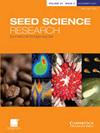Stimulatory and inhibitory effects of light on Cereus repandus (Cactaceae) seed germination are strongly dependent on spectral quality
IF 2.1
3区 生物学
Q2 PLANT SCIENCES
引用次数: 0
Abstract
Abstract In small seeds, light often promotes germination and longer-term exposure to darkness reduces light sensitivity. In cacti inhabiting harsh environments, a rapid response to light exposure is potentially advantageous for seedling establishment. We exposed dark-imbibed seeds of the cactus Cereus repandus to doses of red (RED) light and far-red (FR) light. The seeds exhibited positive photoblastism to RED light. Although the initial levels of germination varied between seed lots, the sensitivity to increasing the RED dose did not. As little as 5 min per day for 4 d was sufficient to saturate the light requirement for germination. The effects of RED light were reversed by FR exposure as long as the interval between RED and FR did not extend to 2 d, by which time the seeds had ‘committed’ to germinate. Dark incubation for 1–2 weeks prior to RED exposure reduced light sensitivity in two seed lots, such that RED only promoted around 20% germination. Phytochrome is assumed to mediate the reversibility of the RED:FR response. High sensitivity to light spectral quality suggests that seeds of C. repandus are able to germinate quickly in high-quality microsites, but seed burial or shading may commit the seeds to form a soil seed bank. The light characteristics of the germination trait in this species are typical of many small seeded species of the drylands.光对谷神星(仙人掌科)种子发芽的刺激和抑制作用强烈依赖于光谱质量
摘要在小种子中,光照通常会促进发芽,长期暴露在黑暗中会降低感光度。在居住在恶劣环境中的仙人掌中,对光照的快速反应可能有利于幼苗的建立。我们将仙人掌Cereus repandus的深色吸收种子暴露在一定剂量的红色(red)光和远红色(FR)光下。种子对红光表现出正的耐光性。尽管不同种子批次的初始发芽水平不同,但对增加RED剂量的敏感性并不相同。每天5分钟,持续4天就足以使发芽所需的光照饱和。只要RED和FR之间的间隔不延长到2天,到那时种子已经“承诺”发芽,FR暴露就可以逆转红光的影响。在RED暴露前进行1-2周的黑暗培育降低了两批种子的感光度,因此RED只促进了约20%的发芽。植物色素被认为介导RED:FR反应的可逆性。对光谱质量的高灵敏度表明,C.repandus的种子能够在高质量的微型站点中快速发芽,但种子埋藏或遮荫可能会使种子形成土壤种子库。该物种发芽特性的光照特征是旱地许多小种子物种的典型特征。
本文章由计算机程序翻译,如有差异,请以英文原文为准。
求助全文
约1分钟内获得全文
求助全文
来源期刊

Seed Science Research
生物-植物科学
CiteScore
3.60
自引率
4.80%
发文量
23
审稿时长
>12 weeks
期刊介绍:
Seed Science Research, the official journal of the International Society for Seed Science, is a leading international journal featuring high-quality original papers and review articles on the fundamental aspects of seed science, reviewed by internationally distinguished editors. The emphasis is on the physiology, biochemistry, molecular biology and ecology of seeds.
 求助内容:
求助内容: 应助结果提醒方式:
应助结果提醒方式:


